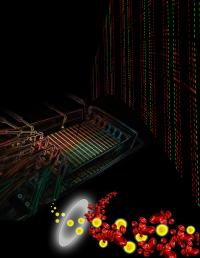
Caltech researchers separate blood stem cells from other bone marrow cells and load them onto a newly developed microfluidic chip. Fluorescent signals indicate the presence of secreted proteins with one... In the battle against infection, immune cells are the body's offense and defense—some cells go on the attack while others block invading pathogens. It has long been known that a population of blood stem cells that resides in the bone marrow generates all of these immune cells. But most scientists have believed that blood stem cells participate in battles against infection in a delayed way, replenishing immune cells on the front line only after they become depleted.
Now, using a novel microfluidic technique, researchers at Caltech have shown that these stem cells might be more actively involved, sensing danger signals directly and quickly producing new immune cells to join the fight.
"It has been most people's belief that the bone marrow has the function of making these cells but that the response to infection is something that happens locally, at the infection site," says David Baltimore, president emeritus and the Robert Andrews Millikan Professor of Biology at Caltech. "We've shown that these bone marrow cells themselves are sensitive to infection-related molecules and that they respond very rapidly. So the bone marrow is actually set up to respond to infection."
The study, led by Jimmy Zhao, a graduate student in the UCLA-Caltech Medical Scientist Training Program, will appear in the April 3 issue of the journal Cell Stem Cell.
In the work, the researchers show that blood stem cells have all the components needed to detect an invasion and to mount an inflammatory response. They show, as others have previously, that these cells have on their surface a type of receptor called a toll-like receptor. The researchers then identify an entire internal response pathway that can translate activation of those receptors by infection-related molecules, or danger signals, into the production of cytokines, signaling molecules that can crank up immune-cell production. Interestingly, they show for the first time that the transcription factor NF-κB, known to be the central organizer of the immune response to infection, is part of that response pathway.
To examine what happens to a blood stem cell once it is activated by a danger signal, the Baltimore lab teamed up with chemists from the lab of James Heath, the Elizabeth W. Gilloon Professor and professor of chemistry at Caltech. They devised a microfluidic chip—printed in flexible silicon on a glass slide, complete with input and output ports, control valves, and thousands of tiny wells—that would enable single-cell analysis. At the bottom of each well, they attached DNA molecules in strips and introduced a flow of antibodies—pathogen-targeting proteins of the immune system—that had complementary DNA. They then added the stem cells along with infection-related molecules and incubated the whole sample. Since the antibodies were selected based on their ability to bind to certain cytokines, they specifically captured any of those cytokines released by the cells after activation. When the researchers added a secondary antibody and a dye, the cytokines lit up. "They all light up the same color, but you can tell which is which because you've attached the DNA in an orderly fashion," explains Baltimore. "So you've got both visualization and localization that tells you which molecule was secreted." In this way, they were able to measure, for example, that the cytokine IL-6 was secreted most frequently—by 21.9 percent of the cells tested.
"The experimental challenges here were significant—we needed to isolate what are actually quite rare cells, and then measure the levels of a dozen secreted proteins from each of those cells," says Heath. "The end result was sort of like putting on a new pair of glasses—we were able to observe functional properties of these stem cells that were totally unexpected."
The team found that blood stem cells produce a surprising number and variety of cytokines very rapidly. In fact, the stem cells are even more potent generators of cytokines than other previously known cytokine producers of the immune system. Once the cytokines are released, it appears that they are able to bind to their own cytokine receptors or those on other nearby blood stem cells. This stimulates the bound cells to differentiate into the immune cells needed at the site of infection.
"This does now change the view of the potential of bone marrow cells to be involved in inflammatory reactions," says Baltimore.
Heath notes that the collaboration benefited greatly from Caltech's support of interdisciplinary work. "It is a unique and fertile environment," he says, "one that encourages scientists from different disciplines to harness their disparate areas of expertise to solve tough problems like this one."
Source : debwms@caltech.edu
 Print Article
Print Article Mail to a Friend
Mail to a Friend
